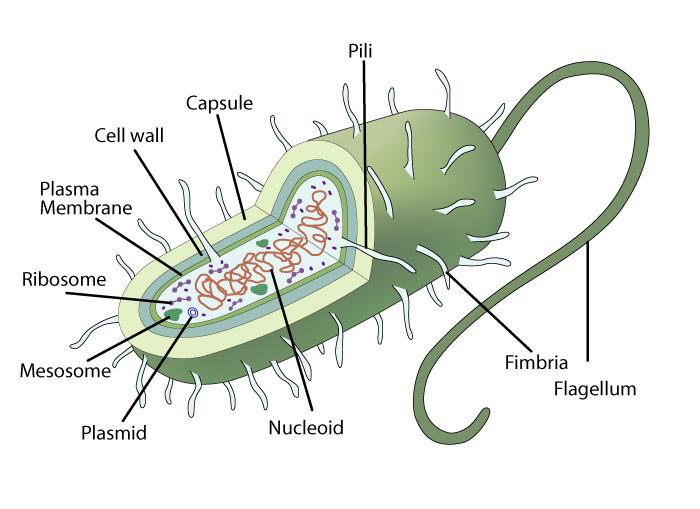Prokaryotic cell is one of the simplest forms of cell which makes up the unicellular microscopic organisms called acrhaea and bacteria. However, there are some cyanobacteria which are multicellular.
Prokaryotic cell, which has the similar size as that of the mitochondria, is visible only through light and electronic microscope. Most of these cells have diameter ranging from 0.1 to 5.0 µm. But, there are some cells (example: Thiomargarita namibiensis) whose diameter is noted to be 750 µm.
Organelles and Cell Components of Prokaryotic Cell
Cell wall
Cell wall is the outermost layer of the prokaryotic and all other types of cell. In archaea, the cell wall is composed of isoprene while the composition is peptidoglycan in the bacteria. It protects the cell from dehydration and external environment, and maintains typical shape. Besides, the cell wall is composed of various dissolved solutes; as a result, the highly concentrated composition prevents osmotic lysis (the bursting of the cell due to increase in volume of internal constituents).
Plasma membrane
Plasma membrane is the layer that surrounds the entire cell. It is a thin layer of lipid that lies just below the cell wall. Typically, a plasma membrane is 6 to 8 nm thick bilayer of phospholipid but some archaean cell is also known to have monolayer.
Plasma membrane is semi-permeable in nature. It allows waste product to pass through it but prevents diffusion of proteins, ions and other essential dissolved solutes into the external environment.
Cytoplasm
Cytoplasm is the jelly-like substance that is present inside the plasma membrane. Made up of nearly 80% of water, cytoplasm is composed of various water soluble protein, carbohydrate, inorganic salts, lipids, etc.
Cytoplasm is also responsible for maintaining shape of the cell; without it the cell would be flaccid. In addition, it holds all the cell organelles such as nucleoid, ribosome, plasmid, and others in their place.
Nucleoid
Prokaryotic cells lack defined nucleus or membrane-bound nucleus. But, the genetic material of the cell is located more or less centrally in the irregularly-shaped region which is known as nucleoid. Usually, the genetic material is circular, single or double stranded DNA.
Plasmid
Plasmid is an independent small circular DNA which is found only in some bacteria. Plasmid carries out the function of exchanging genetic information along with various genetic advantages.
Ribosome
Ribosome is a complex molecule of RNA-protein found in all living cells. The major of the ribosome is to carry out protein synthesis (translation of RNA into proteins). Besides, it also carries out functions such as reading the RNA, and linking with amino acids to assemble polypeptide chain.
Mesosome
Present in most of the prokaryotic cells, mesosome is a small irregularly shaped organelles which consists of ribosomes.
Pilus
Found in all prokaryotic cells, pilus is a hair like structure sticking out the plasma membrane. They can be found in multiple numbers and collectively they are called pili. It helps in exchange of genetic material during conjugation.
Fimbria
Fimbria is also a hair like appendage, found in almost all prokaryotic cells. They are also found in multiple numbers and are collectively called fimbriae. Unlike Pilus, fimbria helps in attaching to the host cell.
Flagellum
Flagellum is a protein filament, suspending in most of the prokaryotic cells. It helps in locomotion and also in chemotaxis (response made to chemical present in the surrounding).
Carboxysome
Carboxysome is small protein-shell compartments found only in some bacteria. It is responsible for carbon fixation and plays major role carbon-concentrating mechanism (CCM).
Chlorosome
Chloroplast is absent in prokaryotic cell but chlorophyll can be found scattered in the cytoplasm. These chlorophyll when arranged with protein molecules forms light harvesting complex which is known as chlorosome. The complex helps in carrying out photosynthesis in the cell. However, this complex is only found in Green Sulfur Bacteria.
